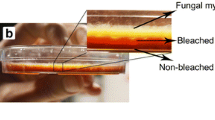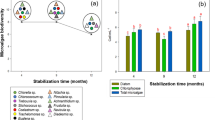Abstract.
Flavodon flavus (Klotzsch) Ryvarden, a basidiomycete (NIOCC strain 312) isolated from decomposing leaves of a sea grass, decolorized pigments in molasses spent wash (MSW) by 80% after 8 days of incubation, when used at concentrations of 10% and 50%. Decolorizing activity was also present in media prepared with half-strength seawater (equivalent to 15 ppt salinity). Decolorizing activity was seen in low-nitrogen medium, nutrient-rich medium and in sugarcane bagasse medium. The percentage decolorization of MSW was highest when glucose or sucrose was used as the carbon source in the low-nitrogen medium. The production of lignin-modifying enzymes, manganese-dependent peroxidase (MNP) and laccase decreased in a medium containing MSW. MNP production and MSW decolorization were inversely correlated, suggesting no role for MNP in MSW decolorization. The decolorization of MSW was not effective when F. flavus was immobilized in calcium alginate beads. Decolorization was achieved best in oxygenated cultures. Besides color, total phenolics and chemical oxygen demand were reduced by 50% in MSW treated with F. flavus, suggesting its potential in the bioremediation of effluents.
Similar content being viewed by others
Author information
Authors and Affiliations
Additional information
Received revision: 8 November 2000
Electronic Publication
Rights and permissions
About this article
Cite this article
Raghukumar, C., Rivonkar, G. Decolorization of molasses spent wash by the white-rot fungus Flavodon flavus, isolated from a marine habitat. Appl Microbiol Biotechnol 55, 510–514 (2001). https://doi.org/10.1007/s002530000579
Received:
Accepted:
Issue Date:
DOI: https://doi.org/10.1007/s002530000579




